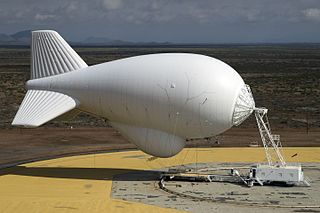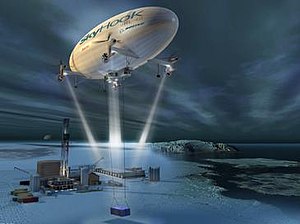
An aircraft is a vehicle that is able to fly by gaining support from the air. It counters the force of gravity by using either static lift or the dynamic lift of an airfoil, or, in a few cases, direct downward thrust from its engines. Common examples of aircraft include airplanes, helicopters, airships, gliders, paramotors, and hot air balloons.
A vertical take-off and landing (VTOL) aircraft is one that can take off and land vertically without relying on a runway. This classification can include a variety of types of aircraft including helicopters as well as thrust-vectoring fixed-wing aircraft and other hybrid aircraft with powered rotors such as cyclogyros/cyclocopters and gyrodynes.

The Boeing CH-47 Chinook is a tandem-rotor helicopter originally developed by American rotorcraft company Vertol and now manufactured by Boeing Defense, Space & Security. The Chinook is a heavy-lift helicopter that is among the heaviest lifting Western helicopters. Its name, Chinook, is from the Native American Chinook people of Oregon and Washington state.

An airship or dirigible balloon is a type of aerostat or lighter-than-air aircraft that can navigate through the air under its own power. Aerostats gain their lift from a lifting gas that is less dense than the surrounding air.

A tiltrotor is an aircraft that generates lift and propulsion by way of one or more powered rotors mounted on rotating shafts or nacelles usually at the ends of a fixed wing. Almost all tiltrotors use a transverse rotor design, with a few exceptions that use other multirotor layouts.
The CarterCopter is an experimental compound autogyro developed by Carter Aviation Technologies in the United States to demonstrate slowed rotor technology. On 17 June 2005, the CarterCopter became the first rotorcraft to achieve mu-1 (μ=1), an equal ratio of airspeed to rotor tip speed, but crashed on the next flight and has been inoperable since. It is being replaced by the Carter Personal Air Vehicle.
Skyhook, sky hook or skyhooks may refer to:

The Sikorsky CH-54 Tarhe is an American twin-engine heavy-lift helicopter designed by Sikorsky Aircraft for the United States Army. It is named after Tarhe, an 18th-century chief of the Wyandot Indian tribe whose nickname was "The Crane". The civilian version is the Sikorsky S-64 Skycrane.

An aerostat is a lighter-than-air aircraft that gains its lift through the use of a buoyant gas. Aerostats include unpowered balloons and powered airships. A balloon may be free-flying or tethered. The average density of the craft is lower than the density of atmospheric air, because its main component is one or more gasbags, a lightweight skin containing a lifting gas to provide buoyancy, to which other components such as a gondola containing equipment or people are attached. Especially with airships, the gasbags are often protected by an outer envelope.

A hybrid airship is a powered aircraft that obtains some of its lift as a lighter-than-air (LTA) airship and some from aerodynamic lift as a heavier-than-air aerodyne.

The Sikorsky CH-53K King Stallion is a heavy-lift cargo helicopter designed and produced by Sikorsky Aircraft. The King Stallion is an evolution of the long running CH-53 series of helicopters which have been in continuous service since 1966, and features three uprated 7,500 shp (5,590 kW) engines, new composite rotor blades, and a wider aircraft cabin than its predecessors. It is the largest and heaviest helicopter in the U.S. military.
A convertiplane is defined by the Fédération Aéronautique Internationale as an aircraft which uses rotor power for vertical takeoff and landing (VTOL) and converts to fixed-wing lift in normal flight. In the US it is further classified as a sub-type of powered lift. In popular usage it sometimes includes any aircraft that converts in flight to change its method of obtaining lift.

The Sikorsky X2 is an experimental high-speed compound helicopter with coaxial rotors, developed by Sikorsky Aircraft, that made its first flight in 2008 and was officially retired in 2011.

The Bell Boeing Quad TiltRotor (QTR) is a proposed four-rotor derivative of the Bell Boeing V-22 Osprey developed jointly by Bell Helicopter and Boeing. The concept is a contender in the U.S. Army's Joint Heavy Lift program. It would have a cargo capacity roughly equivalent to the C-130 Hercules, cruise at 250 knots, and land at unimproved sites vertically like a helicopter.

A tethered, moored or captiveballoon is a balloon that is restrained by one or more tethers attached to the ground and so it cannot float freely. The base of the tether is wound around the drum of a winch, which may be fixed or mounted on a vehicle, and is used to raise and lower the balloon.

The Boeing Vertol XCH-62 was a triple-turbine, heavy-lift helicopter project designed for the United States Army by Boeing Vertol. Approved in 1971, one prototype reached 95% completion before it was canceled in 1975. The prototype was scrapped in 2005.
Aeros Corp is an American manufacturer of airships based in Los Angeles, California. It was founded in 1993 by the current CEO and Chief Engineer, Igor Pasternak, who was born in Soviet Kazakhstan, raised in Soviet Ukraine, and moved to the U.S. after the Soviet collapse to build airships there. It currently employs more than 100 workers.
Karem Aircraft, Inc. is an American aerospace manufacturer company with offices in Lake Forest, California; York, Virginia; and Victorville, California, founded in 2004 by Abraham Karem as a rapid development firm specializing in advanced tiltrotor transport aircraft. Karem was the former chief designer for the Israeli Air Force — who built his first drone during 1973's Yom Kippur War — and has been described by The Economist as the man who "created the robotic plane that transformed the way modern warfare is waged — and continues to pioneer other airborne innovations". He emigrated to the United States in the late 1970s.

The Piasecki PA-97 Helistat was an American experimental heavy-lift aircraft, built by Piasecki by fastening four H-34J helicopters to a framework beneath a helium-inflated blimp envelope. The sole prototype was lost during a test flight, killing a test pilot and injuring another four in the course of a single incident.













